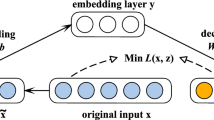Abstract
Missing data is a significant problem impacting all domains. State-of-the-art framework for minimizing missing data bias is multiple imputation, for which the choice of an imputation model remains nontrivial. We propose a multiple imputation model based on overcomplete deep denoising autoencoders. Our proposed model is capable of handling different data types, missingness patterns, missingness proportions and distributions. Evaluation on several real life datasets show our proposed model significantly outperforms current state-of-the-art methods under varying conditions while simultaneously improving end of the line analytics.
Ke Wang’s work was supported by a discovery grant from the Natural Sciences and Engineering Research Council of Canada.
Access this chapter
Tax calculation will be finalised at checkout
Purchases are for personal use only
Similar content being viewed by others
References
Beaulieu-Jones, B.K., Moore, J.H.: The pooled resource open-access ALS, and clinical trials consortium. Missing data imputation in the electronic health record using deeply learned autoencoders. In: Pacific Symposium on Biocomputing, vol. 22, pp. 207. NIH Public Access (2016)
Bengio, Y., Yao, L., Alain, G., Vincent, P.: Generalized denoising auto-encoders as generative models. In: Advances in Neural Information Processing Systems, pp. 899–907 (2013)
Buuren, S., Groothuis-Oudshoorn, K.: MICE: multivariate imputation by chained equations in R. J. Stat. Softw. 45(3), 1–68 (2011)
Chen, P.: Optimization algorithms on subspaces: revisiting missing data problem in low-rank matrix. Int. J. Comput. Vis. 80(1), 125–142 (2008)
Duan, Y., Lv, Y., Kang, W., Zhao, Y.: A deep learning based approach for traffic data imputation. In: 2014 IEEE 17th International Conference on Intelligent Transportation Systems (ITSC), pp. 912–917. IEEE (2014)
LeCun, Y., Bengio, Y., Hinton, G.: Deep learning. Nature 521(7553), 436–444 (2015)
Leisch, F., Dimitriadou, E.: Machine learning benchmark problems (2010)
Li, S., Kawale, J., Fu, Y.: Deep collaborative filtering via marginalized denoising auto-encoder. In: Proceedings of the 24th ACM International on Conference on Information and Knowledge Management, pp. 811–820. ACM (2015)
Little, R.J.A.: Missing-data adjustments in large surveys. J. Bus. Econ. Stat. 6(3), 287–296 (1988)
Little, R.J.A., Rubin, D.B.: Statistical Analysis with Missing Data. Wiley, Hoboken (2014)
Morris, T.P., White, I.R., Royston, P.: Tuning multiple imputation by predictive mean matching and local residual draws. BMC Med. Res. Methodol. 14(1), 75 (2014)
Nelwamondo, F.V., Mohamed, S., Marwala, T.: Missing data: A comparison of neural network and expectation maximisation techniques. arXiv preprint arXiv:0704.3474 (2007)
Nesterov, Y.: A method of solving a convex programming problem with convergence rate O (1/k2) (1983)
Rubin, D.B.: Inference and missing data. Biometrika 63, 581–592 (1976)
Schafer, J.L.: Multiple imputation: a primer. Stat. Methods Med. Res. 8(1), 3–15 (1999)
Shah, A.D., Bartlett, J.W., Carpenter, J., Nicholas, O., Hemingway, H.: Comparison of random forest and parametric imputation models for imputing missing data using MICE: a CALIBER study. Am. J. Epidemiol. 179(6), 764–774 (2014)
Sterne, J.A.C., White, I.R., Carlin, J.B., Spratt, M., Royston, P., Kenward, M.G., Wood, A.M., Carpenter, J.R.: Multiple imputation for missing data in epidemiological and clinical research: potential and pitfalls. BMJ 338, b2393 (2009)
Vincent, P., Larochelle, H., Bengio, Y., Manzagol, P.-A.: Extracting and composing robust features with denoising autoencoders. In: Proceedings of the 25th International Conference on Machine Learning, pp. 1096–1103. ACM (2008)
Author information
Authors and Affiliations
Corresponding author
Editor information
Editors and Affiliations
Rights and permissions
Copyright information
© 2018 Springer International Publishing AG, part of Springer Nature
About this paper
Cite this paper
Gondara, L., Wang, K. (2018). MIDA: Multiple Imputation Using Denoising Autoencoders. In: Phung, D., Tseng, V., Webb, G., Ho, B., Ganji, M., Rashidi, L. (eds) Advances in Knowledge Discovery and Data Mining. PAKDD 2018. Lecture Notes in Computer Science(), vol 10939. Springer, Cham. https://doi.org/10.1007/978-3-319-93040-4_21
Download citation
DOI: https://doi.org/10.1007/978-3-319-93040-4_21
Published:
Publisher Name: Springer, Cham
Print ISBN: 978-3-319-93039-8
Online ISBN: 978-3-319-93040-4
eBook Packages: Computer ScienceComputer Science (R0)




